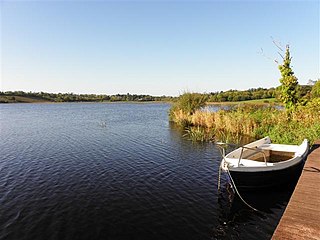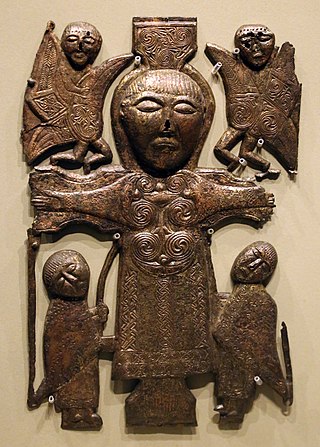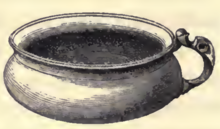
The Wessex culture is the predominant prehistoric culture of central and southern Britain during the early Bronze Age, originally defined by the British archaeologist Stuart Piggott in 1938.

Grooved ware is the name given to a pottery style of the British Neolithic. Its manufacturers are sometimes known as the Grooved ware people. Unlike the later Beaker ware, Grooved culture was not an import from the continent but seems to have developed in Orkney, early in the 3rd millennium BC, and was soon adopted in Great Britain and Ireland.

The court cairn or court tomb is a megalithic type of chambered cairn or gallery grave. During the period, 3900–3500 BC, more than 390 court cairns were built in Ireland and over 100 in southwest Scotland. The Neolithic monuments are identified by an uncovered courtyard connected to one or more roofed and partitioned burial chambers. Many monuments were built in multiple phases in both Ireland and Scotland and later re-used in the Early Bronze Age.

A bowl is a typically round dish or container generally used for preparing, serving, storing, or consuming food. The interior of a bowl is characteristically shaped like a spherical cap, with the edges and the bottom forming a seamless curve. This makes bowls especially suited for holding liquids and loose food, as the contents of the bowl are naturally concentrated in its center by the force of gravity. The exterior of a bowl is most often round, but can be of any shape, including rectangular.

Keshcarrigan is a village in County Leitrim, Ireland. It is situated on the Shannon-Erne Waterway and R209 road and under Sheebeg, an ancient pagan burial site which overlooks Lough Scur to the north and Keshcarrigan Lough to the south. Keshcarrigan features in the writing of the novelist John McGahern who lived nearby.

The prehistory of Ireland has been pieced together from archaeological evidence, which has grown at an increasing rate over the last decades. It begins with the first evidence of permanent human residence in Ireland around 10,500 BC and finishes with the start of the historical record around 400 AD. Both the beginning and end dates of the period are later than for much of Europe and all of the Near East. The prehistoric period covers the Palaeolithic, Mesolithic, Neolithic, Bronze Age and Iron Age societies of Ireland. For much of Europe, the historical record begins when the Romans invaded; as Ireland was not invaded by the Romans its historical record starts later, with the coming of Christianity.
Food vessels are an Early Bronze Age, c. 2400–1500 BC, pottery type. It is not known what food vessels were used for and they only received their name as antiquarians decided they were not beakers and so it provided a good contrast. Recently, the concept of the food vessels was questioned by many archaeologists in favour of a concept of two different traditions: the bowl tradition and the vase tradition. Vases are tall vessels with their height being greater than their largest diameter, while bowls are short vessels with their height being less than or equal to their greatest diameter.
The Rudge Cup is a small enamelled bronze cup found in 1725 at Rudge, near Froxfield, in Wiltshire, England. The cup was found down a well on the site of a Roman villa. It is important in that it lists five of the forts on the western section of Hadrian's Wall, thus aiding scholars in identifying the forts correctly. The information on the cup has been compared with the two major sources of information regarding forts on the Wall, the Notitia Dignitatum and the Ravenna Cosmography.

The National Museum of Ireland – Archaeology is a branch of the National Museum of Ireland located on Kildare Street in Dublin, Ireland, that specialises in Irish and other antiquities dating from the Stone Age to the Late Middle Ages.

A dui is a type of Chinese ritual bronze vessel used in the late Zhou dynasty and the Warring States period of ancient China. It was a food container used as a ritual vessel. Most dui consist of two bowls supported on three legs.

The Torrs Horns and Torrs Pony-cap are Iron Age bronze pieces now in the National Museum of Scotland, which were found together, but whose relationship is one of many questions about these "famous and controversial" objects that continue to be debated by scholars. Most scholars agree that horns were added to the pony-cap at a later date, but whether they were originally made for this purpose is unclear; one theory sees them as mounts for drinking-horns, either totally or initially unconnected to the cap. The three pieces are decorated in a late stage of La Tène style, as Iron Age Celtic art is called by archaeologists. The dates ascribed to the elements vary, but are typically around 200 BC; it is generally agreed that the horns are somewhat later than the cap, and in a rather different style.

Rathgall, or the Ring of the Rath is a large multivallate hill fort near the town of Shillelagh. Dating from the Bronze Age, it consists of three roughly concentric stone ramparts with a fourth masonry wall dating from the Medieval period at its centre. Rathgall is a National Monument which is in state care.

Lough Scur is a freshwater lake in south County Leitrim, northwest Ireland. It is part of the Shannon–Erne Waterway. There have been Human settlements here since the New Stone Age. Modern features include quays and moorings. Protected features are Castle John, three Crannogs, and the causeway into Rusheen Island, though "Jail Island" is not protected. The ecology of Lough Scur, and indeed all county Leitrim lakes, is threatened by pollution and invasive species such as curly waterweed, zebra mussel, and freshwater clam.

Castlefore Lough is a mesotrophic freshwater lake in County Leitrim, Ireland. Known for good coarse fishing, the lake has limited bank fishing. The ecology of Castlefore Lough, and other county waterways, is threatened by curly waterweed, zebra mussel, and freshwater clam invasive species.
Lough Marrave is a small freshwater lake in County Leitrim in the northwest of Ireland.

The Benty Grange hanging bowl is a fragmentary Anglo-Saxon artifact from the seventh century AD. All that remains are parts of two escutcheons: bronze frames that are usually circular and elaborately decorated, and that sit along the outside of the rim or at the interior base of a hanging bowl. A third one disintegrated soon after excavation, and it no longer survives. The escutcheons were found in 1848 by the antiquary Thomas Bateman, while excavating a tumulus at the Benty Grange farm in western Derbyshire. They were presumably buried as part of an entire hanging bowl. The grave had probably been looted by the time of Bateman's excavation, but still contained high-status objects suggestive of a richly furnished burial, including the hanging bowl and the boar-crested Benty Grange helmet.

The Rinnegan Crucifixion Plaque is a late 7th or early 8th century Irish gilt-bronze crucifixion plaque sculpture found in the 19th century in the churchyard of St. John’s on the head of Lough Ree in Rinnegan County Westmeath, and near Athlone, County Roscommon. It is one of the earliest extant representations of the crucifixion in Irish art, and outside of illuminated manuscripts, a rare example of both representation and a narrative scene in early Irish Insular art.

Phoenician metal bowls are approximately 90 decorated bowls made in the 7th–8th centuries BCE in bronze, silver and gold, found since the mid-19th century in the Eastern Mediterranean and Iraq. They were historically attributed to the Phoenicians, but are today considered to have been made by a broader group of Levantine peoples.

The Corleck Head is an Irish three-faced stone idol usually dated to the 1st or 2nd century AD. Although its origin is not known for certain, its placing in the Early Iron Age is based on the iconography, which is similar to that of other northern European Celtic artefacts from that period. Archaeologists agree that it probably depicts a Celtic god and was intended to be placed on top of a larger shrine associated with a Celtic head cult. Its use probably continued through the early Christian period into early modern celebrations of the Lughnasadh, a Gaelic pagan harvest festival.

















